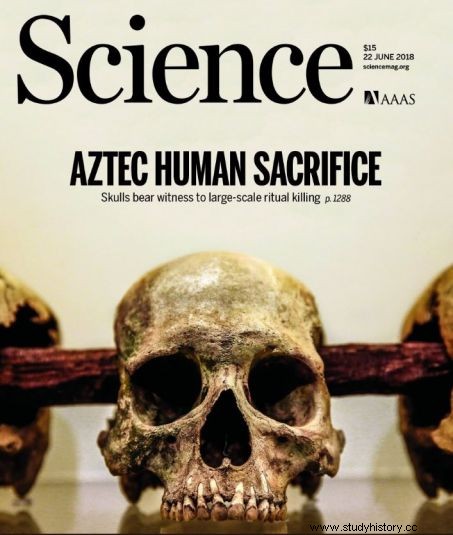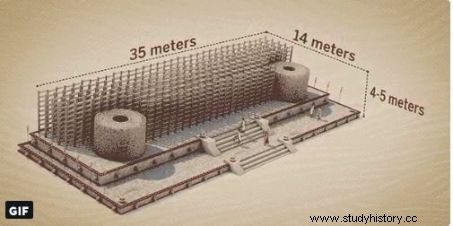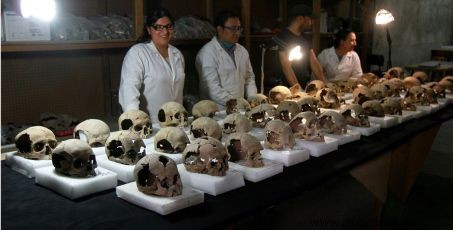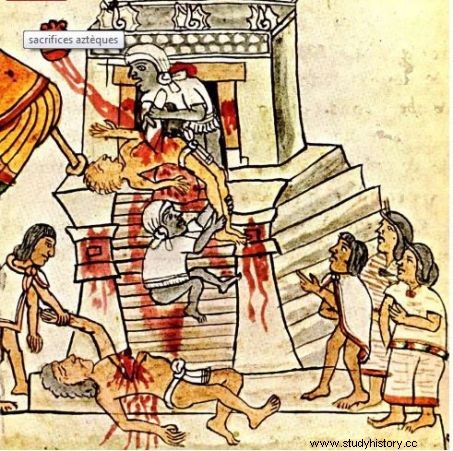Thousands of skulls found in the tzompantli of Tenochtitlan, ancient Mexico, reveal the massive scale of human sacrifice practiced in the Aztec capital.

Thousands of human skulls were found between 2015 and 2017 at the site of the ancient tzompantli of the Aztec capital Tenochtitlan, present-day Mexico City.
Cover of the journal Science June 22, 2018, the American scientific weekly reports on the spectacular discoveries of tzompantli de Mexico, carried out between 2015 and 2017. We reproduce the articles that Sciences et Avenir devoted to these "skull racks", amended with reconstructions produced by Mexican archaeologists from the National Institute of Anthropology and History (INAH). "For the Aztecs - the largest cultural group to which the Mexica belonged - these skulls were the seeds that would ensure the survival of mankind. They were a sign of life and regeneration, like the first flowers of spring" , explained Raul Barrera Rodriguez, the Mexican specialist at the head of the project.

Cover of the journal Science of June 22, 2018.©Science
After two years of study, it was possible to establish that the great tzompantli of Tenochtitlan on which thousands of human skulls were actually "strung" was an imposing rectangular structure 35m long by 12 to 14 meters wide by a height of 4 to 5 meters. Two towers of mortared skulls, 5 meters wide by 1.7 meters high, flanked both sides of the tzompantli .

Reconstruction of the tzompantli of Tenochtitlan, ancient Mexico. ©INAH
Specialists estimate that the construction phases of this veritable "skull abacus" are between 1486 and 1502, although human sacrifices were practiced in the ancient Aztec capital from its foundation in 1325. "Even if it is difficult to conceive today, these structures were not intended to terrify but they were part of a ceremonial whole" , said Gregory Pereira, research director of the Department of Archeology of the Americas, at the CNRS (UMR 8096).
"Aztec tower of human skulls discovered in Mexico City" , article published in Sciences et Avenir on July 5, 2017.
A dramatic twist . In the basements of Mexico City, the current Mexican capital, the ancient Tenochtitlan of the Aztecs, stands a sinister tower made of human skulls. Discovered in 2015, it gradually reveals its terrible secrets to archaeologists. Thus, among the 675 skulls of sacrificed men patiently exhumed for a year and a half, anthropologists were amazed to identify women and children, where they thought they would only find those of warriors! “A real surprise” , told The Guardian daily , Raul Barrera, researcher at the National Institute of History and Anthropology of Mexico (INAH), responsible for the excavations.

Some of the skulls from the human sacrifices displayed in the tower, under study. © Jessica Espinosa /Notimex/AFP
The spooky architecture, about 6 meters in diameter, was located within the sacred enclosure of the Templo Mayor, the most important ceremonial center of the Aztecs, not far from the sanctuary dedicated to Huitzilopochtli , the god of the sun. The tower would have been part of the terrifying Huey Tzompantli , a “skull rack” described in historical chronicles. This enormous collection, which had horrified the Spaniards when they arrived in Tenochtitlan , was mentioned by Andres de Tapia, a companion of Hernan Cortes, who had participated in the conquest of Mexico in 1521. “[…] towers made of lime and skulls, without any other stone, and teeth outward as far as could be seen […] ”, had described the conquistador. The Spaniards were appalled by the violence of human sacrifice practiced in the Aztec civilization, understood as “the killing of human beings in communication with the superhuman ”, which was explained in his book* Michel Graulich (1944-2015), one of the best specialists in the religions of Mesoamerica.

Illustration of a sacrificial ceremony from the Codex Magliabechiano.
These macabre finds now raise new questions about ritual ceremonies and the selection of victims. Bernardino de Sahagún (1499-1590), a Spanish Franciscan missionary, famous for his pioneering work on Aztec ethnology, already related in his General History of Things in New Spain that during certain festivals all the captives, prisoners of war, were sacrificed. Both men and women and children. Wars (yaoyotl ) were then incessant in subjugating the cities, with the delivery of victims to be sacrificed as a tribute.
Still in progress, the work of archaeologists should deliver a larger number of skulls. The base of the site has not yet been reached.
*Human Sacrifice among the Aztecs , Michel Graulich, Fayard.
